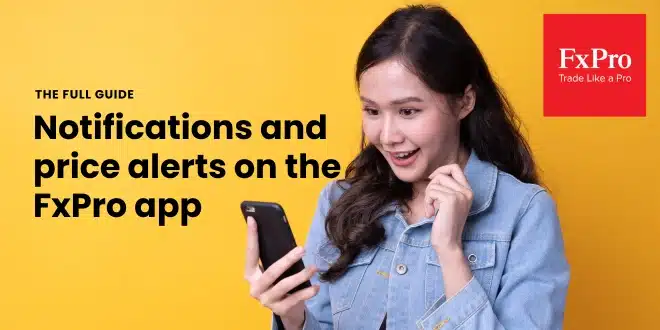When you’re trading, every second matters. Prices can spike or drop in a flash—and if you’re not watching, you might miss a key opportunity or get caught in a risky move. That’s where FxPro’s notifications and price alerts come in.
This guide walks you through everything—how to set up alerts, where to use them, how they support real strategies, and how to avoid common mistakes. Whether you’re trading full time or watching markets between meetings, alerts help you trade smarter, not harder.
Why Alerts Matter More Than You Think
Alerts aren’t just helpful—they’re vital. Markets don’t wait for anyone. With alerts, you stay in control even when you’re not glued to your phone or laptop.
Real story: A gold trader set an alert at 2360 before heading to bed. When the alert triggered overnight, he reviewed the chart in the morning, spotted a rejection, and shorted gold successfully—without watching candles all night.
That’s the power of a well-placed alert. It’s not about speed—it’s about readiness.
Types of Alerts on the FxPro App
FxPro provides a variety of alerts tailored to different use cases. Here’s what’s available—and why they matter:
Price Alerts
These let you know when an asset hits a certain level. It’s like setting tripwires on your chart. The app will notify you the moment price touches your defined target.
Example: You want to buy EUR/USD if it breaks 1.0900. You set an alert at 1.0895. When triggered, you check momentum before entering. No more guesswork or missed entries.
News Alerts
FxPro’s economic calendar lets you create alerts for upcoming macroeconomic events. These are ideal for avoiding nasty surprises or trading planned volatility.
Use case: You trade GBP pairs. You set alerts for upcoming Bank of England statements. This gives you prep time to reduce risk or scout setups.
Order Notifications
Get notified when an order is filled, adjusted, or stopped out. You don’t have to constantly check your platform—FxPro tells you what happened.
Real value: If you’re multitasking or trading several positions, these alerts prevent missed fills or unintended exposure.
Margin and Equity Alerts
These alerts monitor your account health. If your equity or margin drops near danger levels, you’ll be warned before things spiral.
Why it’s critical: With leverage, even a small move can wipe out your balance. Margin alerts help you manage risk proactively—not reactively.
Custom Indicator Alerts (MT4/MT5)
If you’re using MetaTrader platforms, you can set alerts based on technical indicators like RSI, MACD, or moving averages. This requires a little setup but offers deep customization.
Use case: You want to be alerted only if RSI crosses 70 and price is above a resistance zone. You can do that with MT5’s logic or a custom EA in MT4.
How to Set Price Alerts (Step-by-Step)
- Open the FxPro app and log in. Tap on the ‘Markets’ tab.
- Choose the instrument (e.g., EUR/USD). Tap the symbol to view its chart.
- Tap the bell icon or “Alerts”. Usually top-right of the screen.
- Set the price level. Choose whether the alert should trigger when price goes above or below your chosen value.
- Confirm and save. You’ll get a push notification when the conditions are met.
How Alerts Fit Into a Real Trading Strategy
Alerts help you stay prepared—not just informed. Here’s how different traders use them:
- Breakout Traders. Set alerts near resistance/support. When triggered, review the setup. Only enter if momentum confirms. This avoids false breakouts.
- Swing Traders. Set alerts at pullback zones—like a 50 EMA or Fibonacci level. Let the alert bring you back to the chart only when price reaches your plan zone.
- Range Traders. Identify horizontal channels. Set alerts at the edges. You don’t have to watch the chart all day—just wait for a ping, check the reaction, and act accordingly.
- News Traders. Use alerts both before and after big events. Pre-news alerts give you time to prepare. Post-news alerts catch volatile moves or false spikes.
- Beginner Traders. Even if you’re not placing trades, alerts help you watch patterns. Use them to see how markets behave at key levels and build your confidence without pressure.
Creating a Pre-Alert Checklist
Before setting an alert, ask yourself:
- Does this price level matter? (Support, resistance, pivot?)
- What will I do when it triggers—observe, trade, or wait?
- Did I label it clearly for future reference?
- Am I setting too many?
- Is the timing right for the asset’s active session?
Pro Tip: Take 30 seconds to journal your alerts. When they trigger, compare outcome vs expectation. This improves discipline fast.
Deep Dive: MT4 vs MT5 vs FxPro Edge
FxPro supports three main platforms:
MT4 (MetaTrader 4)
- Easy to use with fast setup
- Alerts via “Terminal” → “Alerts” tab
- Supports email, sound, or file actions
- Great for classic forex setups and quick price alerts
Example: Set a sound alert if EUR/USD hits 1.0970. The platform beeps + sends email so you never miss it.
MT5 (MetaTrader 5)
- Supports more complex alerts
- Multi-condition triggers (e.g., time + price)
- Integrated news and better charting
- Preferred by advanced traders
Example: You want an alert only if USD/CAD hits 1.3400 during New York session. MT5 handles this logic with built-in tools.
FxPro Edge (Web App)
- Browser-based, no installation needed
- Clean interface for newer users
- Set price alerts visually on charts
- Ideal for casual or mobile-first traders
Summary: Use MT5 if you want flexibility. MT4 if you prefer speed. FxPro Edge if you’re starting out or prefer simplicity.
When Not to Use Alerts
Alerts are powerful—but not always helpful.
- Avoid setting alerts during dead hours (low liquidity = random spikes)
- Don’t set alerts just for the sake of it
- Skip alerts on symbols you don’t actively trade
- Avoid setting too many (alert fatigue = mental fog)
- Don’t act just because an alert pings—check context first
Setting Alerts Based on News Events
Use FxPro’s economic calendar to set strategic alerts around key events:
- Set alerts 5–15 mins before news releases (e.g., NFP, FOMC)
- Set price alerts beyond known support/resistance for post-news trades
- Label alerts: “watch for breakout” or “possible whipsaw zone”
This approach keeps you calm while others react emotionally.
Alerts for Risk Management (Expanded)
Most traders think of alerts for entries. But experienced traders use them for protection.
1. Equity Drawdown Alerts
Set alerts when your account drops below a certain dollar or percentage value. This reminds you to take a break or re-evaluate your strategy.
Example: If you start the week with $5,000, set an alert at $4,800. If that alert triggers, consider pausing or adjusting risk.
2. Margin Level Alerts
This is essential for leveraged traders. Margin alerts notify you if your margin level approaches dangerous territory (e.g., 120%).
Why it matters: FxPro will auto-close trades if you fall below the required margin level. Alerts give you a chance to add funds, hedge, or close positions manually.
3. Daily Loss Limits
You can set alerts when cumulative losses exceed your daily tolerance. This keeps emotions from spiraling into bad decisions.
Trader Insight: One disciplined trader sets an alert if daily P&L drops by 2%. If it pings, he stops trading—no questions asked.
4. Unrealized Loss Warnings
You may not monitor floating losses closely. Set alerts if any single position reaches a specific negative amount.
Scenario: You’re holding a USD/JPY long. If unrealized loss hits -$150, the alert reminds you to either reassess or take action—before panic kicks in.
Motivational Tip: Using alerts for defense doesn’t mean you’re weak—it means you’re thinking like a pro. Risk control = long-term survival.
Using Alerts in a Mobile Lifestyle
FxPro’s mobile features let you stay sharp without screen addiction.
- During work: Set up alerts in the morning, check updates during breaks.
- At night: Place alerts near levels and sleep peacefully—no more midnight chart checks.
- On vacation: Alerts keep you in touch with the market while you disconnect.
Reminder: Enable background permissions and push notifications. Some phones (especially Android) limit alerts to save battery.
Troubleshooting Real Problems
“I didn’t receive my alert.”
- Check notification permissions
- Make sure app was recently opened
- Reboot the app or reinstall if stuck
“The alert came too late.”
- Consider bid/ask differences—alerts may trigger on one but not the other
- Avoid setting alerts on illiquid pairs
- Test alert speed on demo
“I don’t remember why I set this.”
- Always label alerts: “Pullback entry zone,” “Watch for breakout,” etc.
- Use journals or Notes on MT5
Real Use Cases (Mini-Stories)
Leo the Breakout Hunter
Set alerts before work. One day, an alert pinged during lunch. He checked volume, entered EUR/USD, and hit his target before dinner.
Sasha the Saver
Margin alert triggered at 115%. She closed two small trades, avoided forced liquidation, and kept her equity intact.
Maya the Learner
Used alerts for educational purposes—no trades, just observation. Over 3 weeks, she learned more than watching random videos.
Alex the Night Owl
Set gold alerts at 2360 before bed. In the morning, saw it rejected perfectly. Took a short with full confidence.
What’s Missing from FxPro Alerts?
FxPro’s system is strong—but not perfect.
- No multi-condition logic in the app (e.g., RSI + price combo)
- No SMS or voice alerts
- Sound customizations are limited on mobile
- Indicator-based alerts require MT4/MT5
Workaround: Use TradingView + FxPro together for hybrid workflows.
Final Takeaways
Smart alerts = smart trading. They help you stay calm, focused, and ready. Whether you’re a full-time trader or just starting out, alerts give you back your most valuable asset: time.
Start with one alert. Build from there. The more you use them, the more you’ll trust them—and yourself.
FAQs
1. What’s the difference between a price alert and a trade notification? Price alerts track the market. Trade notifications track your personal orders or positions.
2. Can I set indicator-based alerts? Only on MT4/MT5 or third-party platforms. FxPro app doesn’t support them directly.
3. Do alerts expire? Most stay active until triggered or deleted—but always check app updates or resets.
4. Will alerts trigger if I’m offline? Yes, as long as you’ve enabled push notifications and the app is synced to your account.
5. Can I group or organize alerts? You can name or label them, but no folders or categories are available (yet). Journaling helps bridge the gap.
6. Can I test alerts without risking money? Yes—use a demo account to learn how alerts behave in live market conditions.
7. Are alerts fast enough for scalping? Not always. Scalpers usually rely on direct chart watching or desktop platforms like MT4 with custom scripts.


